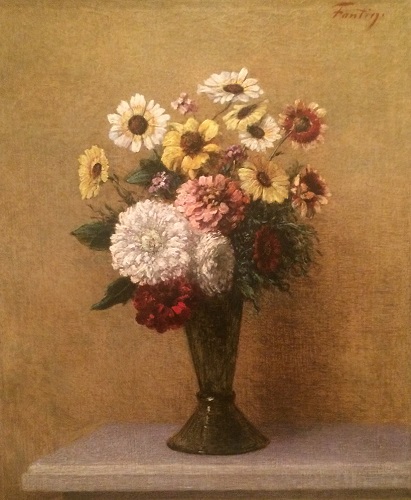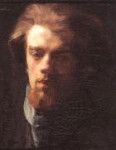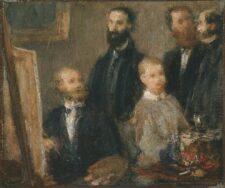
Henri Fantin-Latour
French, 1836-1904
Chrysanthemums of Summer, 1887 ca.
oil on canvas
18 1/8 x 15 in.
SBMA, Gift of Mary and Leigh Block
1987

Undated self-portrait of Fantin-Latour, oil on canvas
"After the Romantic movement, born of classicizing exaggeration, after the Realist movement, product of the follies of Romanticism, it may be seen that there is a great foolishness in all these ideas. We are going to achieve a personal manner of feeling.“ - Letter from Fantin-Latour to Edwin Edwards, 14 April 1866
RESEARCH PAPER
Henri Fantin-Latour's "Chrysanthemums" is an oil on canvas. The exact date of this painting's execution is unknown. Fantin's flower paintings are distributed over a long space of time. There were some years between 1864 and 1896 when he painted little else. He painted flowers when he stayed at the country house of Mr. and Mrs. Edwin Edwards at Sunbury-on-Thames.
In England, Fantin-Latour was considered an eminent specialist in flower painting. He did not covet this position. His ambitions were those of a Romantic, his great talents were those of a Realist. He was able to sell his flower pieces to English patrons, who delighted in them, when he could interest them in nothing else.
Like the Flemish masters, Fantin's vivid use of color and shadings gave his flower paintings brilliance. He understood that, in a bouquet of flowers, each flower makes its own statement. His soft light makes the flowers come to life, tracing and exploring their outlines.
Fantin's artistic development over the years is interesting in that there is so little of it; he accepted the tonal painting of his day as the normal mode for the representation of objects he chose to paint. In his flower paintings his coloring was high-keyed and he used such "old master" methods as glazes and scumbles. He achieved in these works an "overall" effect in which no portion of the canvas was treated more emphatically than any other. This odd quality is particularly attractive today, because it produces an effect of impenetrability. It seems, looking at these paintings, as if there is a distance between the subject and ourselves.
By isolating the floral group against a plain background, Fantin further enhanced a feeling of mystery. His Realism appears almost to have been produced by a camera. It may be supposed that it is for this reason his flowers found such favor in England. His most distinctive characteristic was his objectivity. Still life enabled him to express his love of painting for itself, rather than a fascination with subject.
Henri Fantin-Latour was born in Grenoble France on January 14, 1836. He was the son of a Russian mother and a French portrait painter. As a young man, he studied drawing and painting with his father. Later, after moving to Paris, he studied in the atelier of Lecoq de Boibaudran. In 1854, Fantin became a probationary student at the Ecole des Beaux-Arts, but left after three months without gaining full admission. He gained a basic technical ability from these lessons. The greatest influence in Fantin-Latour's early years was the time spent in the Louvre, copying the old masters. He particularly admired Delacroix, Veronese, Titian, Giorgione, Tintoretto, Rubens, Rembrandt, Hals, and Chardin, and very often made copies of them for a living. The huge gallery of the Louvre was always crowded with copyists, and it was there he met James Whistler, thus beginning a friendship lasting for many years.
In 1859, Whistler introduced Fantin to London art society. Here, he met Edwin Edwards, a lawyer, amateur painter, and etcher, who became the principal means of gaining a clientele in England for his flowers and still lifes. Despite his success in England, nothing would induce him to leave Paris for any length of time. Fantin said, "If one never sells anything, yet one has the perfect liberty to paint what one likes."
Although he admired Courbet and Monet, and their influences can be detected in his still lifes, he remained apart from the Impressionist movement toward rendering light through color. Even though Impressionism was gathering force in this period, Fantin believed that, "the time is passed of schools and artistic movements." Unlike his Impressionist contemporaries, who were painting landscapes, he painted only in the studio. He felt that painting out of doors was not for him because the old masters had not done it.
Fantin-Latour, though never a ground-breaker, remained true to his vision. He was an individualist, a sensitive and committed artist who recognized his own limitations and concentrated on his strengths-- he painted what he saw and gave those forms clarity and crystalline brilliance.
Prepared for the Santa Barbara Museum of Art Docent Council by Ann R. Methot, April, 1989.
BIBLIOGRAPHY
Books:
Rewald, John. The History of Impressionism. The Museum of Modern Art, New York, 1946
Exhibition and Collection Catalogs:
Acquavella Galleries, Inc. "Flowers by Fantin-Latour," 1966
Marlborough Fine Art Limited, "Fantin," 1962
Smith College Museum of Art, "Henri Fantin-Latour," 1966
Periodicals:
Los Angeles County Museum of Art, Bulletin, Volume XVI, 1964, Number 1

Fantin-Latour - Manet in his Studio, 1870, The Phillips Collection
COMMENTS
If you’ve already considered that Signac and the others who are doing pointillism often make very beautiful things with it — instead of running those things down, one should respect them and speak of them sympathetically, especially when there’s a falling out.
Otherwise one becomes a narrow sectarian oneself, and the equivalent of those who think nothing of others and believe themselves to be the only righteous ones. This extends even to the academic painters, because take, for example, a painting by Fantin-Latour — and above all his entire oeuvre. Well then — there’s someone who hasn’t rebelled, and does that prevent him, that indefinable calm and righteousness that he has, from being one of the most independent characters in existence?
- Letter from Van Gogh to Emile Bernard, December 1887
SBMA CURATORIAL LABELS
Fantin-Latour produced hundreds of flower paintings over the course of his career, although his aspirations as a portrait and history painter remained his true ambition. Fantin’s undeniable skill at the textural rendering of these colorful blossoms earned him a steady clientele. As Vincent wrote to Theo in March 1885, “I know little by Fantin-Latour, but what I saw I thought very good. Chardinesque. And that’s a lot.”
- Through Vincent's Eyes, 2022
